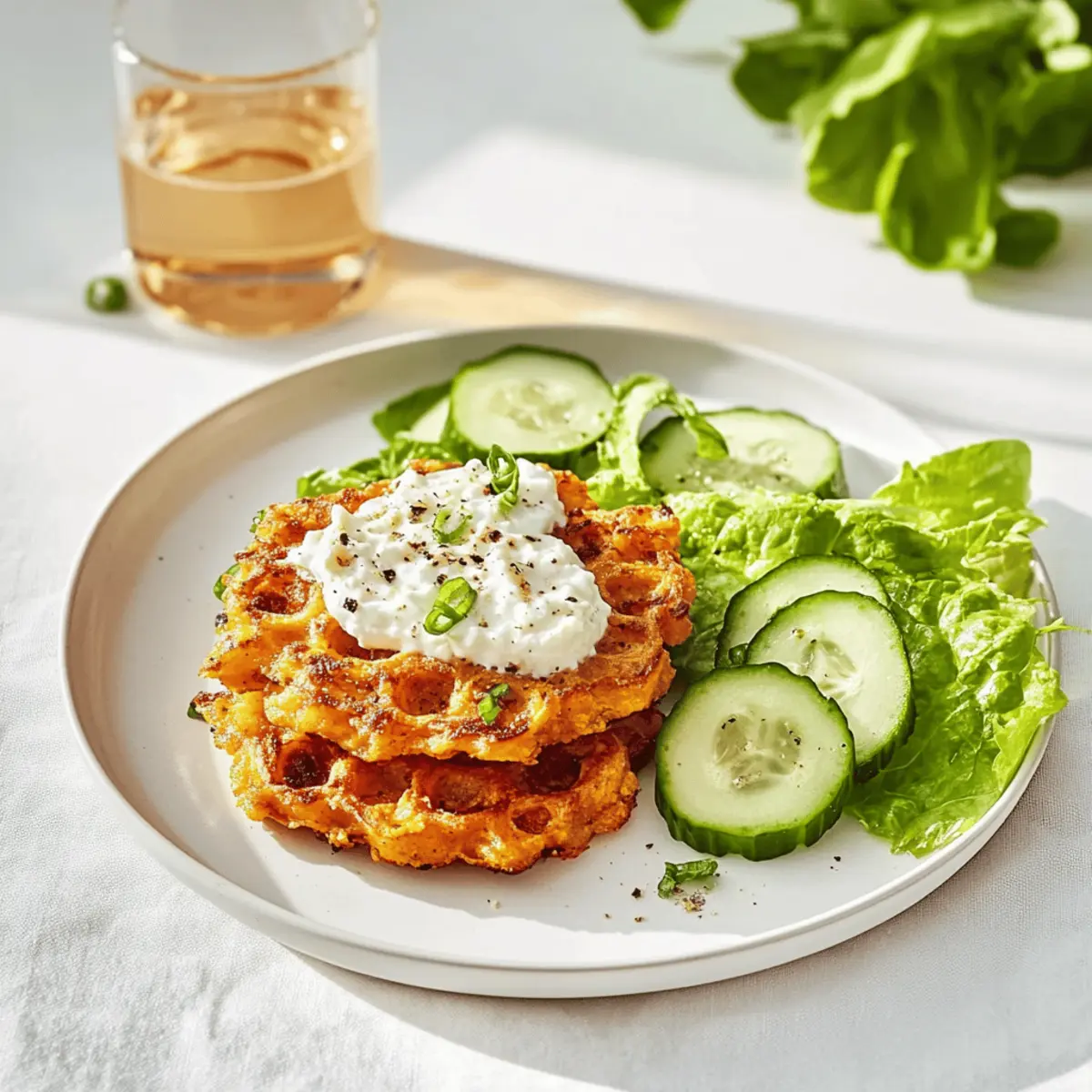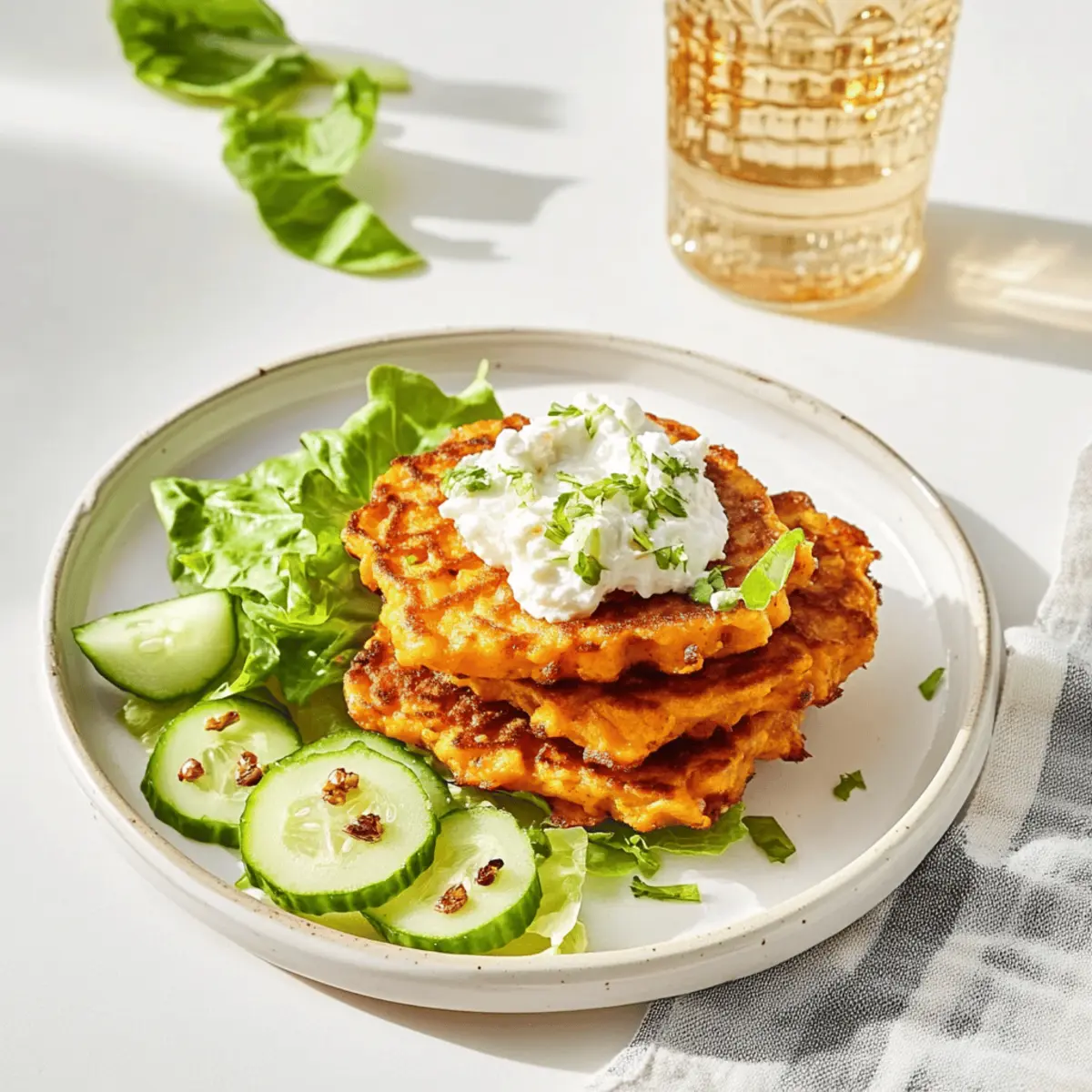As the leaves turn crisp and the air fills with warmth from family gatherings, I find myself drawn to comforting dips that bring health and flavor to the table. This Creamy Butternut Squash Hummus with Feta and Pomegranates is a delightful way to celebrate the season’s bounty. Rich in vitamins and antioxidants, it not only provides a nourishing option for those looking to cut down on fast food but also doubles as a stunning centerpiece for your holiday spread. With its vibrant colors and unexpected sweetness, it's a crowd-pleaser that's both quick to prepare and endlessly adaptable. Whether you’re hosting a festive soirée or simply want to treat yourself to something special, this hummus invites you to dip into something new. Ready to give it a try?

Why is Butternut Hummus So Irresistible?
Creamy, velvety texture that spreads effortlessly on pita or veggies makes this hummus a joy to share. Rich, savory notes from roasted squash and tangy feta create a perfect balance. Colorful pomegranate arils not only brighten the dish but also add a delightful crunch. Quick to make, this recipe fits effortlessly into your hectic schedule while impressing guests. Versatile and customizable, swap feta for a vegan cheese or add spices for your unique twist. It's the ultimate crowd-pleaser for any holiday gathering!
Butternut Hummus with Feta Ingredients
Get ready to whip up a dish that will have everyone asking for the recipe!
For the Hummus
- 1 cup cubed butternut squash – Adds natural sweetness and creaminess; substitute with acorn squash if needed.
- 1 large or 2 medium garlic cloves – Provides aromatic depth; use roasted garlic for a milder, sweeter flavor.
- 1½ cups cooked chickpeas – Main protein source for texture; canned chickpeas are a quick and convenient option.
- ¼ cup tahini – Adds a rich creaminess and nutty flavor; can substitute with sunflower seed butter for a nut-free version.
- 3 tablespoons fresh lemon juice – Brightens the flavors; fresh juice is preferred for the best taste.
- ½ teaspoon cumin – Infuses warmth and earthiness; substitute with smoked paprika for an alternative flavor profile.
- ½ teaspoon coriander – Adds a refreshing citrusy spice; can be omitted if not available.
- ½ teaspoon cayenne – Provides a kick of heat; adjust based on preference or omit for a milder dip.
- ½ teaspoon sea salt – Enhances overall taste; adjust to your liking.
- ¼ cup extra-virgin olive oil – Improves richness and helps in blending; choose high-quality oil for the best flavor.
- ¼ cup water – Helps achieve desired consistency; add as needed for creaminess.
- Freshly ground black pepper – For seasoning; adjust according to preference.
For Topping & Serving
- ¼ cup pomegranate arils – Adds a juicy sweetness and vibrant color.
- ¼ cup feta cheese – Provides a salty, creamy contrast; use vegan cheese for a non-dairy option.
- 2 tablespoons chopped parsley – Brings freshness and color to the presentation.
- 2 tablespoons microgreens (optional) – For an extra pop of garnish and added nutrients.
- Drizzle of olive oil – Enhances richness; use for finishing touches.
- Pita, crackers, and/or assorted veggies – For serving; perfect for dipping into the hummus.
This Butternut Hummus with Feta & Pomegranates is not only healthy but a visual delight that will elevate your holiday gatherings!
Step‑by‑Step Instructions for Butternut Hummus with Feta & Pomegranates
Step 1: Preheat the Oven
Begin by preheating your oven to 400°F (200°C). While the oven heats, line a baking sheet with parchment paper to prevent sticking. This will ensure your butternut squash roasts evenly, developing that sweet flavor we all love. A hot oven will make the squash perfectly tender and caramelized.
Step 2: Prepare the Butternut Squash
In a large mixing bowl, toss the cubed butternut squash with extra-virgin olive oil, sea salt, and freshly ground black pepper. Ensure each piece is well-coated for optimal roasting. Place the seasoned squash on the prepared baking sheet, spreading it out evenly. Wrapping the garlic cloves in aluminum foil with a drizzle of olive oil and salt will keep them fragrant and delicious.
Step 3: Roast the Vegetables
Slide the baking sheet into the preheated oven and roast for 20-25 minutes. Keep an eye on the squash; it should be tender and lightly golden when done. After about 15 minutes, give the squash a gentle stir to ensure even caramelization. The garlic should be soft and aromatic, adding depth to your butternut hummus.
Step 4: Cool and Blend
Once roasted, remove the baking sheet from the oven and let the butternut squash and garlic cool for a few minutes. Transfer them into a food processor along with the cooked chickpeas, tahini, fresh lemon juice, cumin, coriander, cayenne, and sea salt. This blend of ingredients will create the base for your luscious Butternut Hummus with Feta & Pomegranates.
Step 5: Achieve Creamy Consistency
Blend the mixture on high speed, drizzling in the extra-virgin olive oil gradually. This technique helps emulsify the ingredients, yielding a wonderfully creamy texture. If the hummus is too thick, add water a tablespoon at a time until you reach your desired consistency. Taste the mixture and adjust the seasoning if needed, adding more salt or lemon juice for brightness.
Step 6: Transfer and Garnish
Once smooth and creamy, transfer the butternut hummus to a serving bowl. For a festive touch, top the hummus with the vibrant pomegranate arils, crumbled feta cheese, and a sprinkle of chopped parsley. Drizzle with a bit of olive oil for added richness, making your dish not only tasty but visually stunning.
Step 7: Serve with Delight
Pair your Butternut Hummus with Feta & Pomegranates with pita bread, crackers, or fresh veggies for dipping. Arrange everything on a beautiful serving platter to showcase your creation. This dip is perfect for holiday gatherings or a cozy night in, inviting everyone to enjoy the warm, inviting flavors you've lovingly crafted.

How to Store and Freeze Butternut Hummus
Fridge: Store your butternut hummus in an airtight container for up to 5 days. Be sure to give it a good stir before serving, as it may thicken over time.
Freezer: For longer storage, freeze the hummus in a freezer-safe container for up to 3 months. Leave some space at the top for expansion, and thaw overnight in the fridge when ready to enjoy.
Reheating: If frozen, allow the hummus to thaw in the fridge. You can gently warm it in the microwave or on the stovetop, adding a splash of water or olive oil to regain creaminess.
Serving Tips: When ready to serve your butternut hummus with feta & pomegranates, freshen it up by topping with pomegranate arils and a drizzle of olive oil for a beautiful presentation.
Butternut Hummus with Feta Variations
Embrace the joy of creativity in the kitchen by customizing your butternut hummus to match your taste and dietary needs!
- Vegan Option: Omit the feta and replace it with a sprinkle of nutritional yeast for a cheesy flavor without dairy.
- Nut-Free: Swap tahini with sunflower seed butter for that creamy texture without nuts; perfect for allergy-friendly gatherings.
- Heat Lovers: Increase cayenne pepper for a spicy kick or add some finely chopped jalapeños while blending.
- Flavor Boost: Mix in herbs like fresh basil or rosemary to give a fragrant twist to your hummus.
- Dairy-Free: Use silken tofu instead of feta for creaminess without the dairy while maintaining its richness.
- Smoky Flavor: Infuse your hummus with a dash of smoked paprika for a delightful depth of flavor that pairs beautifully with the sweet squash.
- Different Squash: Substitute butternut squash with roasted acorn squash or sweet potatoes for seasonal variety in taste and texture.
- Creamy Indulgence: For a luxuriously smooth texture, add a splash of coconut milk during blending; this makes it incredibly rich and silky.
As you explore these variations, consider pairing your butternut hummus with homemade Skillet Pasta Feta or Buffalo Tofu Caesar. Whether you're looking for something fun and casual or elegant for special gatherings, your creative dips can take center stage!
Expert Tips for Butternut Hummus
-
Choose Quality Ingredients: Fresh butternut squash and high-quality tahini will elevate the flavors. Don’t skimp on the olive oil for a richer taste.
-
Perfect Roasting: Roasting brings out the sweetness in the squash. Ensure all cubes are evenly coated in olive oil, salt, and pepper for perfect caramelization.
-
Emulsify Gradually: When blending the hummus, add the olive oil gradually for a smoother texture. This helps create that creamy consistency everyone will crave.
-
Taste as You Go: Always taste the hummus before serving. Adjust the lemon juice and salt to ensure a delightful balance of flavors that makes your butternut hummus with feta & pomegranates truly shine.
-
Make Ahead: To save time, prepare the hummus a day in advance. Just add the toppings right before serving to keep them fresh and vibrant.
Make Ahead Options
This Butternut Squash Hummus with Feta and Pomegranates is a fantastic option for meal prep! You can prepare the hummus itself up to 3 days in advance; simply store it in an airtight container in the refrigerator. To maintain its creamy texture, add the olive oil gradually when blending and consider a splash of water if it thickens. You can also roast the butternut squash and garlic 24 hours ahead and refrigerate them, keeping their flavors fresh. Just before serving, mix everything together and top with the pomegranate arils and feta to ensure the dish remains vibrant and visually appealing. Enjoy the time-saving benefits while impressing your guests with this delicious dip!
What to Serve with Butternut Hummus with Feta & Pomegranates
Looking to create a delightful spread that will elevate your gathering and tantalize your taste buds?
-
Pita Chips: These crispy, golden bites provide a satisfying crunch that complements the smooth and creamy texture of the hummus beautifully.
-
Fresh Veggie Platter: Crisp cucumbers, sweet bell peppers, and crunchy carrots add freshness and color, making every bite a balanced delight!
-
Spiced Roasted Chickpeas: Crunchy and slightly seasoned, they mirror the chickpeas in the hummus, adding an extra layer of flavor while keeping things healthy.
-
Olive Tapenade: This briny, savory spread creates a wonderful textural contrast and brings a burst of Mediterranean flavor that pairs wonderfully with the sweetness of butternut squash.
-
Quinoa Salad: A light, refreshing quinoa salad full of herbs and citrus can serve as a perfect side, complementing the hummus while offering a nutritious boost.
-
Red Wine: A bottle of smooth red wine brings sophistication to your meal, enhancing the earthy flavors of the hummus and making the evening even more special.
Let your creativity run wild with these pairings, as each addition will create a delightful, shared culinary experience that guests will fondly remember.

Butternut Hummus with Feta and Pomegranates Recipe FAQs
What type of butternut squash should I use?
Absolutely! Choose a firm, heavy butternut squash with a smooth, tan skin. Avoid any with dark spots or blemishes. If butternut isn't available, acorn squash is a great substitute for a similar sweetness and texture.
How should I store leftover hummus?
Very! Store your butternut hummus in an airtight container in the fridge. It will stay fresh for up to 5 days. I recommend stirring it before serving, as it may thicken a bit over time.
Can I freeze butternut hummus?
Of course! To freeze, portion the hummus into a freezer-safe container, leaving some space at the top for expansion. It will keep well for up to 3 months. When you're ready to enjoy it, thaw it overnight in the fridge, and consider adding a splash of olive oil or water while blending to restore creaminess.
What should I do if my hummus is too thick?
No worries! If your butternut hummus is too thick, simply add water or olive oil slowly while blending until you reach your desired consistency. This can make a big difference in smoothing it out – just a tablespoon at a time!
Are there any dietary considerations?
Yes! This recipe can easily accommodate dietary preferences. To make it vegan, simply omit the feta. For nut allergies, consider substituting tahini with sunflower seed butter. Always double-check ingredient labels, especially for processed items like chickpeas and tahini, to ensure they are allergy-friendly.
How long can I keep my mixed ingredients before blending?
If you’re short on time, you can roast your butternut squash and garlic up to a day in advance. Just allow them to cool completely and store them in the refrigerator until you’re ready to blend everything together, which keeps your prep efficient!

Butternut Hummus with Feta & Pomegranates: A Festive Delight
Ingredients
Equipment
Method
- Preheat your oven to 400°F (200°C) and line a baking sheet with parchment paper.
- Toss the cubed butternut squash with extra-virgin olive oil, sea salt, and freshly ground black pepper. Place the seasoned squash on the prepared baking sheet.
- Roast for 20-25 minutes, stirring halfway through. The squash should be tender and lightly golden.
- After roasting, let the butternut squash and garlic cool for a few minutes, then transfer them to a food processor with chickpeas, tahini, lemon juice, cumin, coriander, cayenne, and sea salt.
- Blend the mixture on high speed, adding extra-virgin olive oil gradually until creamy. Adjust consistency with water as needed.
- Transfer the hummus to a serving bowl, topping with pomegranate arils, crumbled feta, and parsley. Drizzle with olive oil.
- Serve with pita bread, crackers, or fresh veggies for dipping.





Leave a Reply